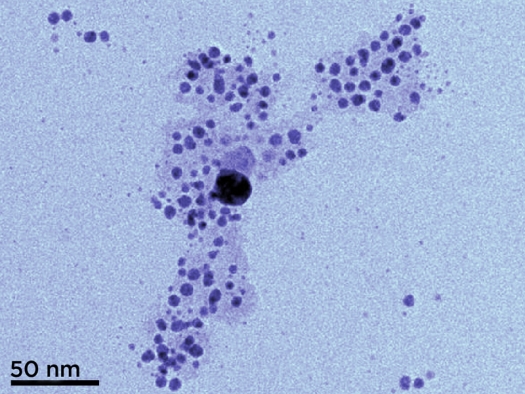SilverNanoparticles.jpg

Silver has a long history, being used for thousands of years as a broad spectrum infection-fighting remedy. That is why the kings used silverware and other vessels made of silver. In the late 1800's the process for making colloidal silver launched a whole new market, using it topically and internally. It was only after the introduction of prescription antibiotics in the 1940's that the use of silver diminished. However, in the 1970's when pathogens developed an immunity to antibiotics, popularity of silver colloids returned.
Silver works in several ways in the body. Research shows tiny silver particles can attach to the DNA of viruses preventing them from replicating. Silver is also an effective oxygen carrier, releasing the oxygen when it comes in contact with a virus, bacteria or fungus, killing it. Also, silver disables the enzyme that bacteria, fungus and virus use for metabolism. Because of these basic mechanisms, pathogens do not develop resistant strains.
Historically silver has been used to treat the following: acne, allergies, appendicitis, arthritis, bubonic plague, burns, cancer, candida, cholera, chronic fatigue, colds, flu, pink eye, styes, diabetes, gonorrhea, hay fever, herpes, leprosy, leukemia, lupus, lymphangitis, Lyme disease, malaria, meningitis, pneumonia, rheumatism, ringworm, scarlet fever, infections of the ears, mouth and throat, shingles, skin cancer, staph infections, strep infections, syphilis, toxemia, viruses, warts and stomach ulcers to mention a few. However, as with all antibiotics, it cannot address every pathogen. Research has found the following to be resistant to silver: Citrobacter Freundii, Enerobacter Cloacae, Enterobacteriaceae, Escherichia Coli, Klebsiella pneumonia, P. Stutzeri, Proteus Mirabilis, and Vegetative B. Cereus Spores.
Silver seems to be well tolerated with very few side effects. If you are allergic to silver (had a reaction to a silver tooth filling) then you should avoid silver. This is a rare occurrence. There is also a condition called argyria where the skin basically tarnishes. This is harmless but quite unsightly. This condition is also rare and occurs mainly from using chemical forms of silver such as silver nitrate. The body eliminates 90-99% of ingested silver within two days. Too much of anything can be dangerous, but the EPA rates the risk of argyria from silver as low. Only a small number of cases have been documented from the millions of users.
It is commonly known that prescription antibiotics can destroy healthy gut bacteria. Colloidal silver that is 99.99% pure silver with particle size ranging from .5 to .05 microns in a concentration of 25 parts per million or less has very little impact on the friendly bacteria in the gut. If a person is taking larger doses of more concentrated silver solutions it would be prudent to supplement with probiotics just to be proactive.
Dr. Robert Becker, who wrote Body Electric, discovered a correlation between low levels of silver in the body and illness. He observed that silver not only killed disease organisms, but also stimulated repair of damaged tissues.
It is one thing to look at colloidal silver as a supplement to address illness. Many, however, look at colloidal silver as a nutrient to address any possible deficiencies of this trace element. Currently there is no official RDA (recommended daily allowance) but researchers indicate that two teaspoons of five parts per million colloidal silver provides about 50 mcg of silver. They consider this a nutritional amount. A therapeutic dose is considered to be 100 mcg.
There are many resources to help the patient determine appropriate dosages. Most nanosilver products range from three parts per million up to 30 parts per million. The bottles offer recommended dosages. For minor infections researchers have found two or three ounces is common. For serious infections even more can be used for a short duration.
When purchasing a colloidal or nanosilver product look for solutions that are electrically generated. The higher parts per million are not always the best as the particles are likely to be larger and not as effective. Solutions that have large particle size will sometimes have particles settled out in the bottom of the container. Particle size in the solution is more important than particle number. The smaller the size, the more effective the treatment. A solution that has a particle size of one nanometer (.001microns) is the most desirable. The solutions should not contain proteins, stabilizers, chemicals, or other additives. It should be clear to lightly golden in color and the consistency of water. There are many reputable companies producing high quality silver solutions which can be found in most health food stores.
Silver is used in many other realms. It is used in fabrics to be antimicrobial. Bandages can be impregnated with silver to promote healing. It is found in water filters such as Pur and Brita. Even NASA uses it as a water purifier. Samsung is developing nanosilver technology in appliances to control bacteria and fungus.
It is important to understand that ionic silver solutions made with electric generators are used effectively in the body. Some products claim to be true colloid, but these have no ionic charge and are therefore limited in bio-availability. It can all become confusing due to marketing campaigns disseminating misleading information. Research has found it is best to use the ionic silver solutions and avoid the true colloid solutions.
FAIM makes every effort to cover helpful aspects of silver colloids and a report such as this just scratches the surface. There are many resources available to learn more about the attributes of nano colloidal silver. One such resource is The Ultimate Colloidal Silver Manual by Steve Barwick. It is a 541 page manual that covers almost every aspect of colloidal silver. Please refer to the FAIM Research section to learn more about studies that have been done using nano/colloidal silver.


